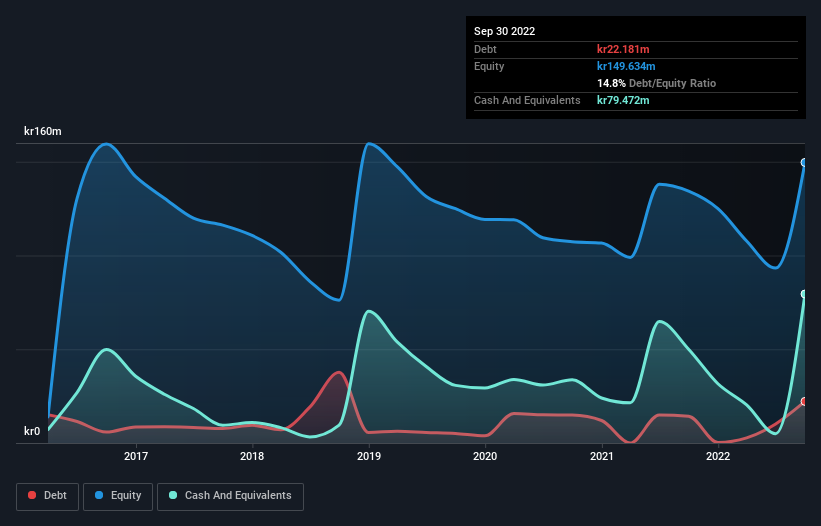
The external fund manager backed by Berkshire Hathaway's Charlie Munger, Li Lu, makes no bones about it when he says 'The biggest investment risk is not the volatility of prices, but whether you will suffer a permanent loss of capital.' When we think about how risky a company is, we always like to look at its use of debt, since debt overload can lead to ruin. Importantly, Enzymatica AB (publ) (STO:ENZY) does carry debt. But the more important question is: how much risk is that debt creating?
When Is Debt Dangerous?
Generally speaking, debt only becomes a real problem when a company can't easily pay it off, either by raising capital or with its own cash flow. Ultimately, if the company can't fulfill its legal obligations to repay debt, shareholders could walk away with nothing. However, a more usual (but still expensive) situation is where a company must dilute shareholders at a cheap share price simply to get debt under control. Having said that, the most common situation is where a company manages its debt reasonably well - and to its own advantage. The first thing to do when considering how much debt a business uses is to look at its cash and debt together.
View our latest analysis for Enzymatica
What Is Enzymatica's Debt?
You can click the graphic below for the historical numbers, but it shows that as of September 2022 Enzymatica had kr22.2m of debt, an increase on kr14.3m, over one year. But on the other hand it also has kr79.5m in cash, leading to a kr57.3m net cash position.

A Look At Enzymatica's Liabilities
We can see from the most recent balance sheet that Enzymatica had liabilities of kr30.6m falling due within a year, and liabilities of kr20.9m due beyond that. On the other hand, it had cash of kr79.5m and kr16.4m worth of receivables due within a year. So it can boast kr44.4m more liquid assets than total liabilities.
This surplus suggests that Enzymatica has a conservative balance sheet, and could probably eliminate its debt without much difficulty. Simply put, the fact that Enzymatica has more cash than debt is arguably a good indication that it can manage its debt safely. When analysing debt levels, the balance sheet is the obvious place to start. But it is future earnings, more than anything, that will determine Enzymatica's ability to maintain a healthy balance sheet going forward. So if you're focused on the future you can check out this free report showing analyst profit forecasts.
In the last year Enzymatica had a loss before interest and tax, and actually shrunk its revenue by 37%, to kr51m. To be frank that doesn't bode well.
So How Risky Is Enzymatica?
By their very nature companies that are losing money are more risky than those with a long history of profitability. And in the last year Enzymatica had an earnings before interest and tax (EBIT) loss, truth be told. And over the same period it saw negative free cash outflow of kr49m and booked a kr57m accounting loss. But at least it has kr57.3m on the balance sheet to spend on growth, near-term. Even though its balance sheet seems sufficiently liquid, debt always makes us a little nervous if a company doesn't produce free cash flow regularly. There's no doubt that we learn most about debt from the balance sheet. However, not all investment risk resides within the balance sheet - far from it. For example - Enzymatica has 4 warning signs we think you should be aware of.
Of course, if you're the type of investor who prefers buying stocks without the burden of debt, then don't hesitate to discover our exclusive list of net cash growth stocks, today.
Valuation is complex, but we're here to simplify it.
Discover if Enzymatica might be undervalued or overvalued with our detailed analysis, featuring fair value estimates, potential risks, dividends, insider trades, and its financial condition.
Access Free AnalysisHave feedback on this article? Concerned about the content? Get in touch with us directly. Alternatively, email editorial-team (at) simplywallst.com.
This article by Simply Wall St is general in nature. We provide commentary based on historical data and analyst forecasts only using an unbiased methodology and our articles are not intended to be financial advice. It does not constitute a recommendation to buy or sell any stock, and does not take account of your objectives, or your financial situation. We aim to bring you long-term focused analysis driven by fundamental data. Note that our analysis may not factor in the latest price-sensitive company announcements or qualitative material. Simply Wall St has no position in any stocks mentioned.
About OM:ENZY
Enzymatica
A life science company, develops and sells products that treat and alleviate infections and symptoms in the upper respiratory tract.
Excellent balance sheet moderate.
Market Insights
Community Narratives



